Go close. Or put it this way: “If your pictures aren’t good enough, you’re not close enough.”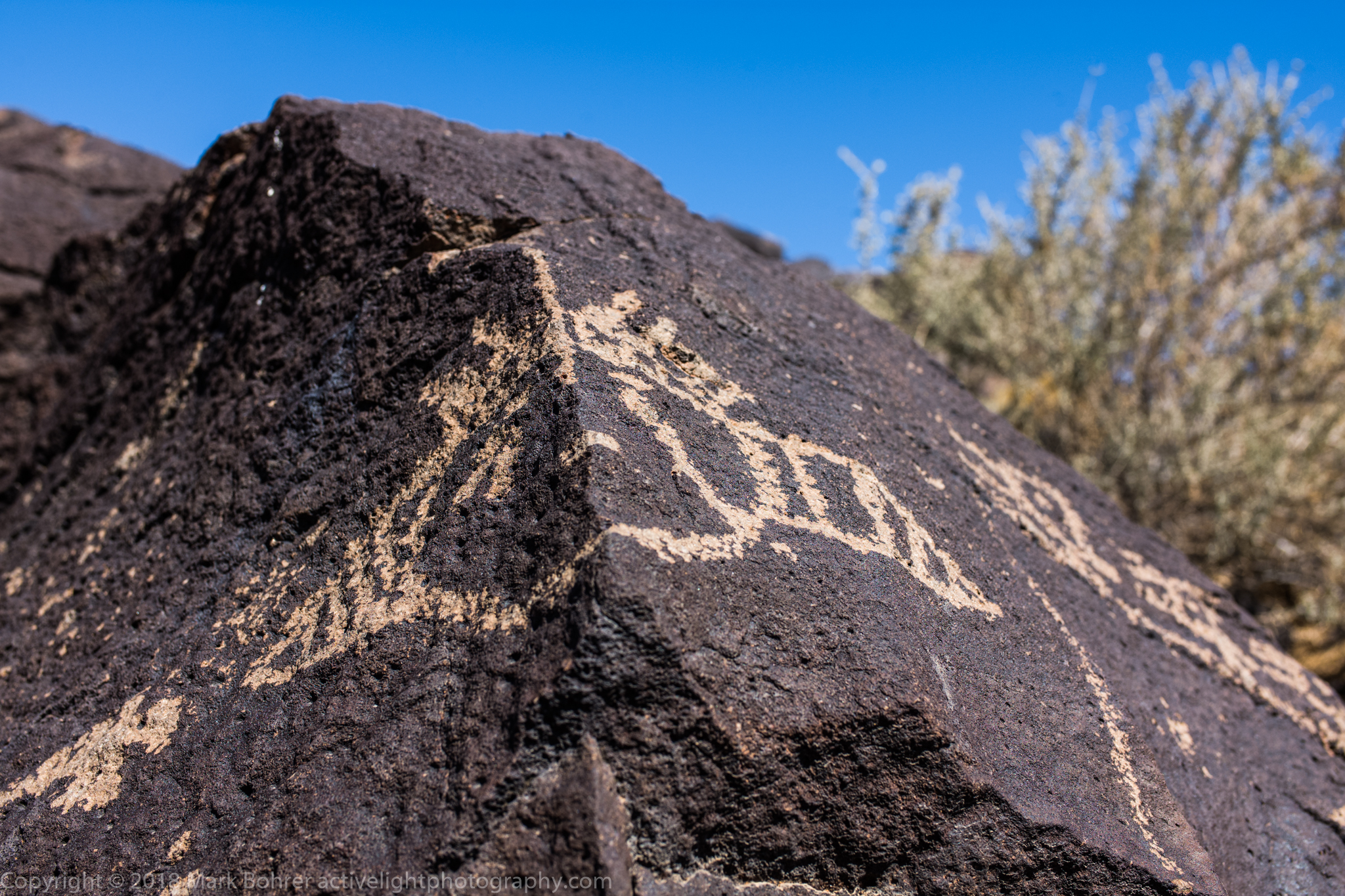 Clan mask, Piedras Marcadas, Petroglyph National Monument Leica M10, 35mm f/1.2 Nokton Aspherical VM II That was Magnum photographer Robert Capa’s famous quote on how to improve your pictures. Capa’s photographs of the Spanish Civil War and the D-Day landing in Normandy were famous records of 20th century war history. His inclination to go close got him killed when he stepped on a landmine in Indochina (now Vietnam) in 1954. I’m not going to cover armed conflict anytime soon, but I do want to get as close as possible to subjects most of the time. I have even more options when I can use a very wide lens aperture. I wrote a bit about going close in my last post. Switching to a full-frame Leica M10 from a crop-sensor Fuji X-E2 meant the Zeiss 25mm lens I’d been using for restaurant food shots was now a little too wide. That was the case even at 19 inches, its closest focusing distance. On the X-E2, the 25mm covered more like a 35mm at full-frame. Beating Those Leica Closeup Limits So I looked around for a 35mm rangefinder lens that focused down to 19 inches on a Leica M-camera. Leica’s own 35mm lenses only go as close as 27.56 inches, the closest focus indication given by the camera’s rangefinder. For food, dogs and other intimate subjects, that’s not enough. I needed the equivalent of an amplifier that goes to 11. I ended up with a super No Like the Zeiss 25mm, the 35mm Nokton performs without focus shift, a change in focusing behavior that can make things blurry as you stop down. In live view close up, I focus my subject at wide-open aperture for maximum precision, then stop down to the taking aperture. A lens with focus shift would no longer be sharply focused where I wanted it as I stopped down. Focusing any lens at a small aperture can be tough, since the additional depth of field makes sharpness a squinty judgement call. So you can be stuck with blurred subjects when you stop down to that small aperture. Isolate With Depth of Field Voigtlander’s 35mm f/1.2 opens up 2 1/2 stops more than your typical f/2.8 zoom. This means extremely narrow depth of field for a wide-angle lens, one of the holy grails of street and event shooting. It also means lower ISOs for less noise in low light. Of course, focusing that narrow DOF can be a problem when it’s dim, and you may want more depth of field too. But for 2 1/2 stops more light, with good-enough optics, for 1/5 the price of a comparable Leica 35mm lens – I’ll take it. The Zeiss 25mm gets me close too, but with fairly broad depth of field at its wide-open f/2.8. I really like isolating subjects with narrow DOF. It brings a 3D look to a flat 2D image, something good film directors do often. How could I get this effect in something wider than 35mm? I picked up a Sigma 14mm f/1.8 Art lens for shooting night sky starfields in February. Right now, it’s the only ultra-wide lens with an f/1.8 aperture and good sharpness. It also focuses down to 10.63 inches. So I went petroglyph-hunting with the 14mm f/1.8 on an EOS 5D mk IV and the 35mm f/1.2 on the Leica M10. 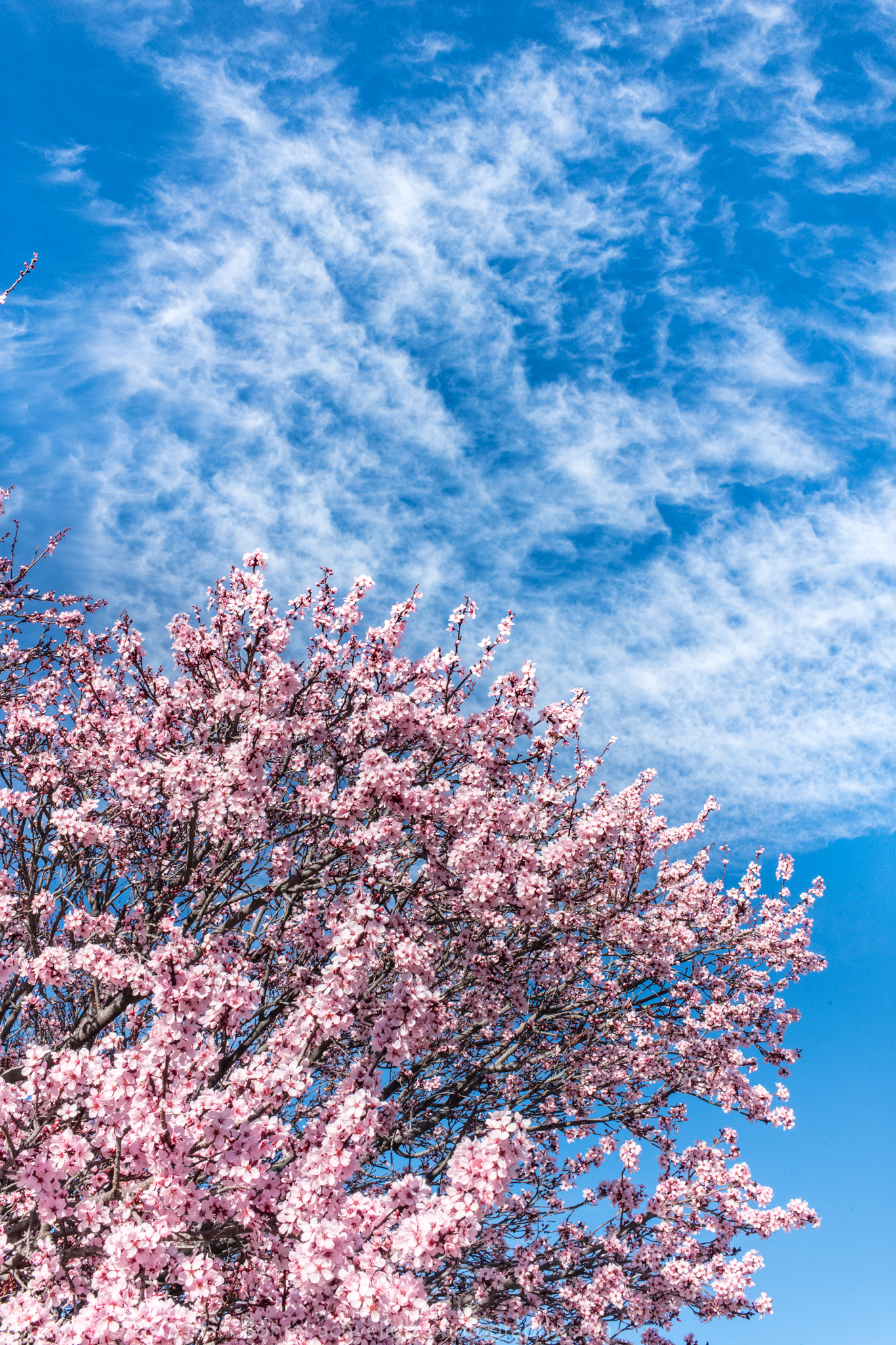 Spring blossoms outside Piedras Marcadas 35mm f/1.2 Nokton Aspherical VM II Getting Close At Petroglyph National Monument I ran into another NPS volunteer when I got to Petroglyph National Monument’s Piedras Marcadas Canyon. He asked me why I was there, and didn’t I have enough petroglyph pictures already? But I was after something I hadn’t done before – in-your-face petroglyph closeups with limited DOF. 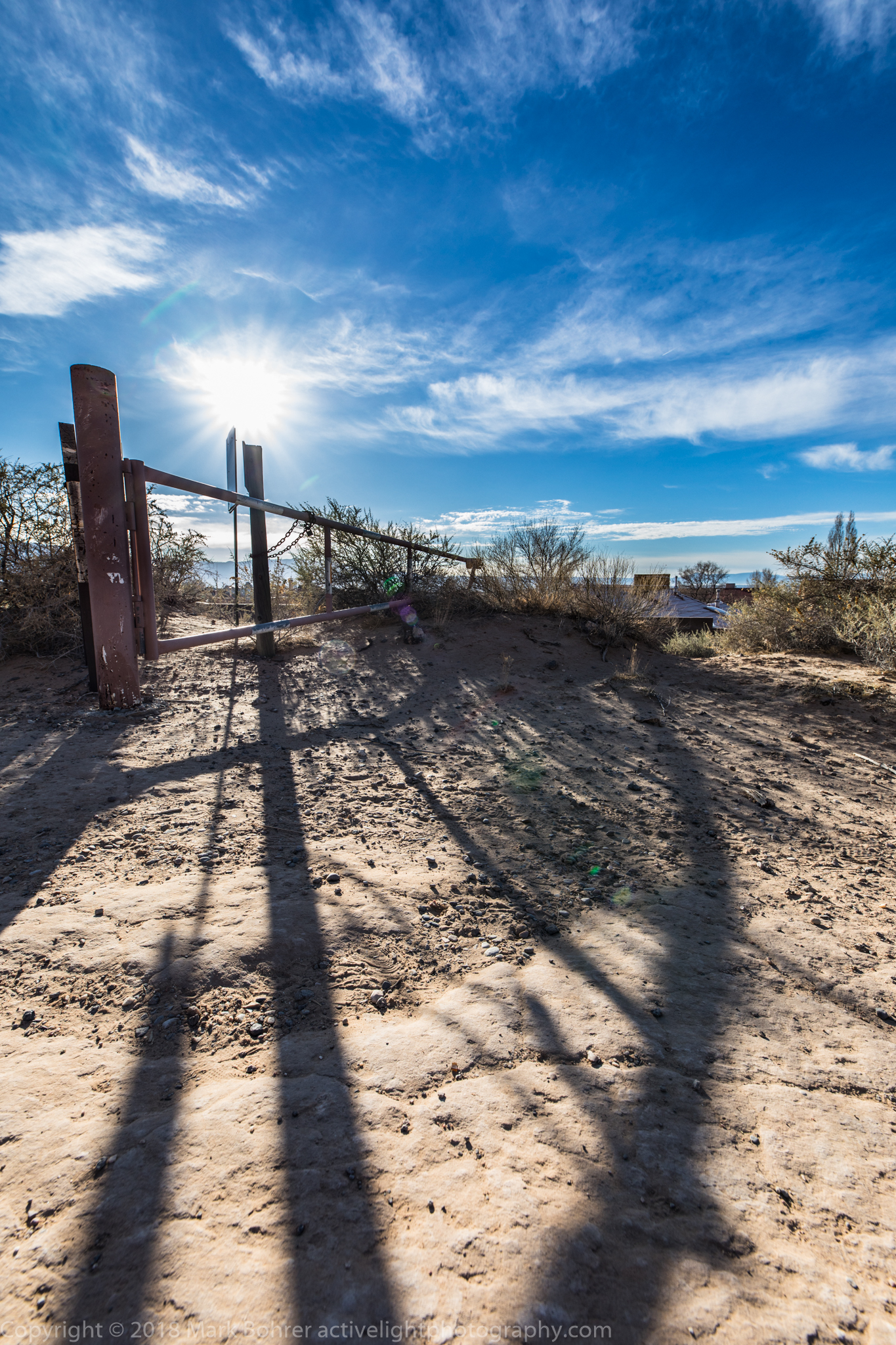 Leading shadows Canon EOS 5D mk IV, Sigma 14mm f/1.8 DG HSM Art Spring blossoms greeted me before I even got inside the park boundary, perfect for an establishing shot. Wispy clouds mirrored the blossoms, so I had an auspiciuous start. Just inside the gate I noticed eye-leading shadow patterns from the boundary fence. I knew the 14mm f/1.8 did well with the sun in the picture, so I stopped down to f/8 for a diffraction sunstar and shot it, kneeling down for a low angle. 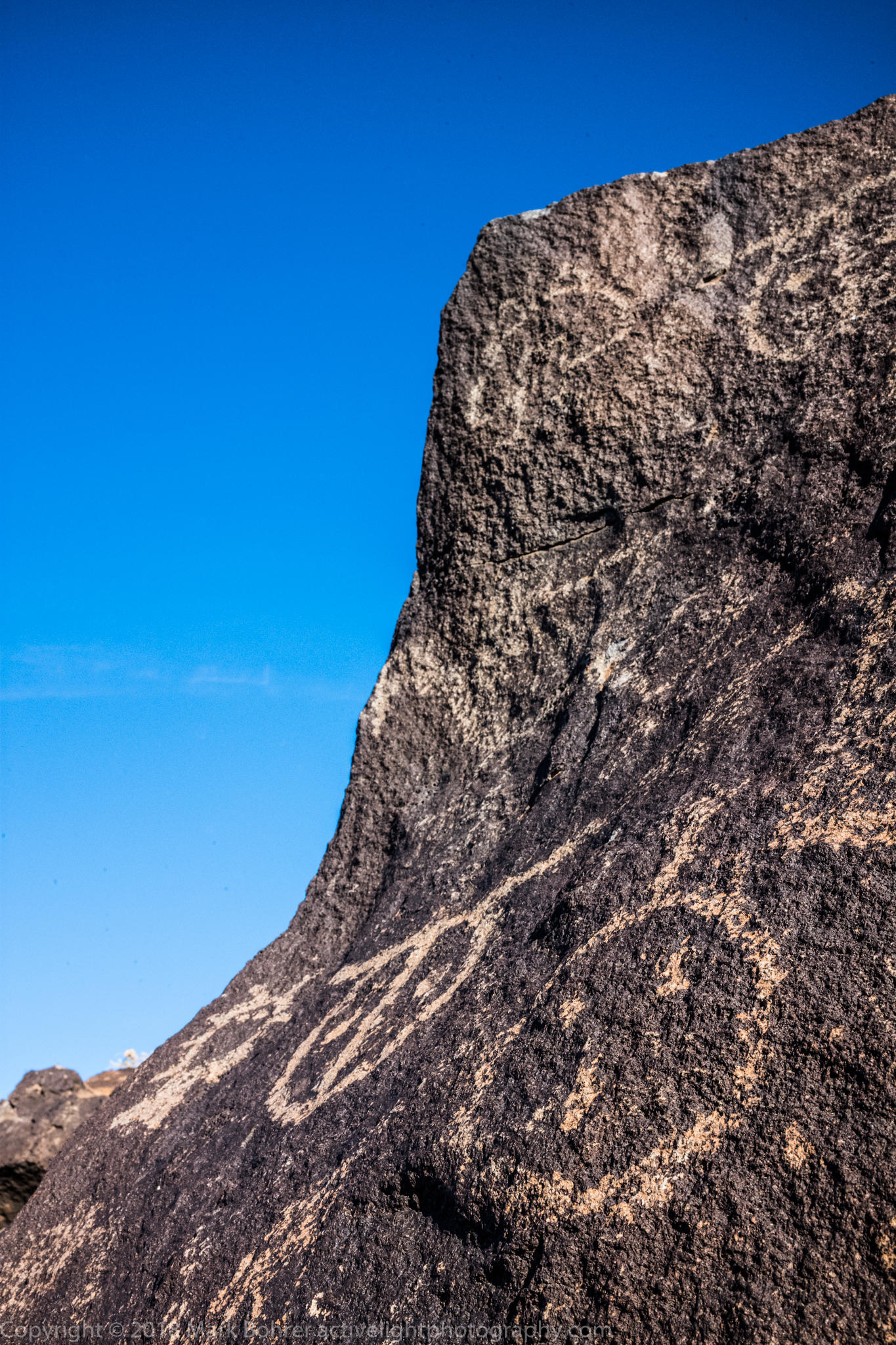 Masks Just around the first turn at signpost 1, there’s a panel with masks I’ve photographed often – from a five to eight foot distance with a longer lens. I focused the 35mm Nokton to 19″ and looked through the M10’s clip-on live view EVF. f/1.2 was too narrow, so I chose f/5.6. I still got a blurred background with the masks mostly sharp. 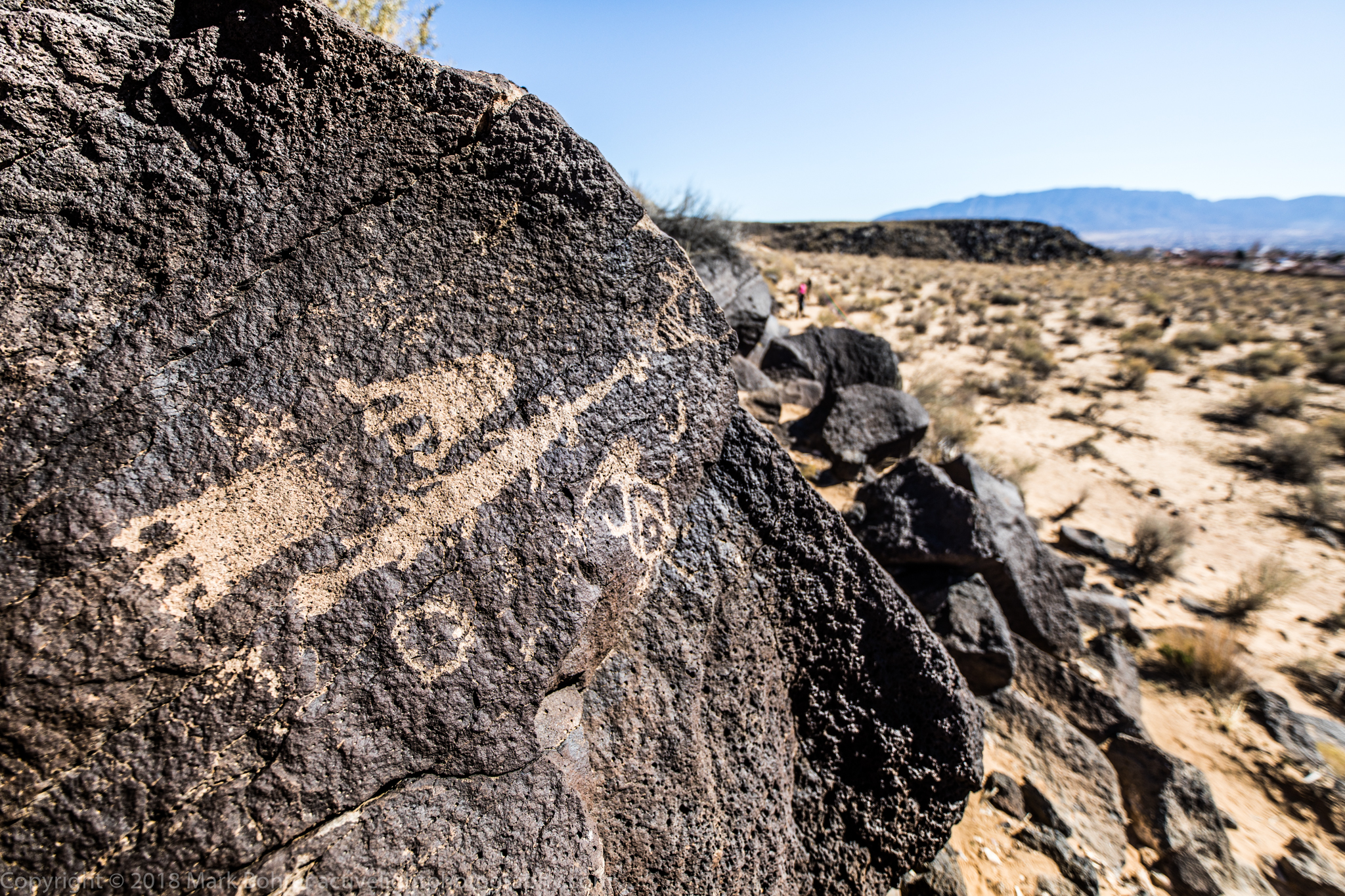 Ancient alien spaceships? 35mm f/1.2 Nokton Aspherical VM II Avoid Sunshine Washout I knew pictures would be washed out shooting in the sun’s direction, so I worked mostly with my back to it. That made keeping my shadow out of the picture a challenge. A pocket tripod minimized my shadow, and gave me an unusual low / close vantage point for closeups. One of these came with clan totems pointing at another visitor in the blurred background. I used the pocket tripod on the side of a rock as a sideways brace. This gave a repeatably-steady viewpoint while I checked the effect of different apertures in live view. A friend who saw the picture later thought it looked like evidence of ancient alien spaceships. (See, petroglyphs can mean whatever you want. Even modern Puebloans disagree on their meanings.) 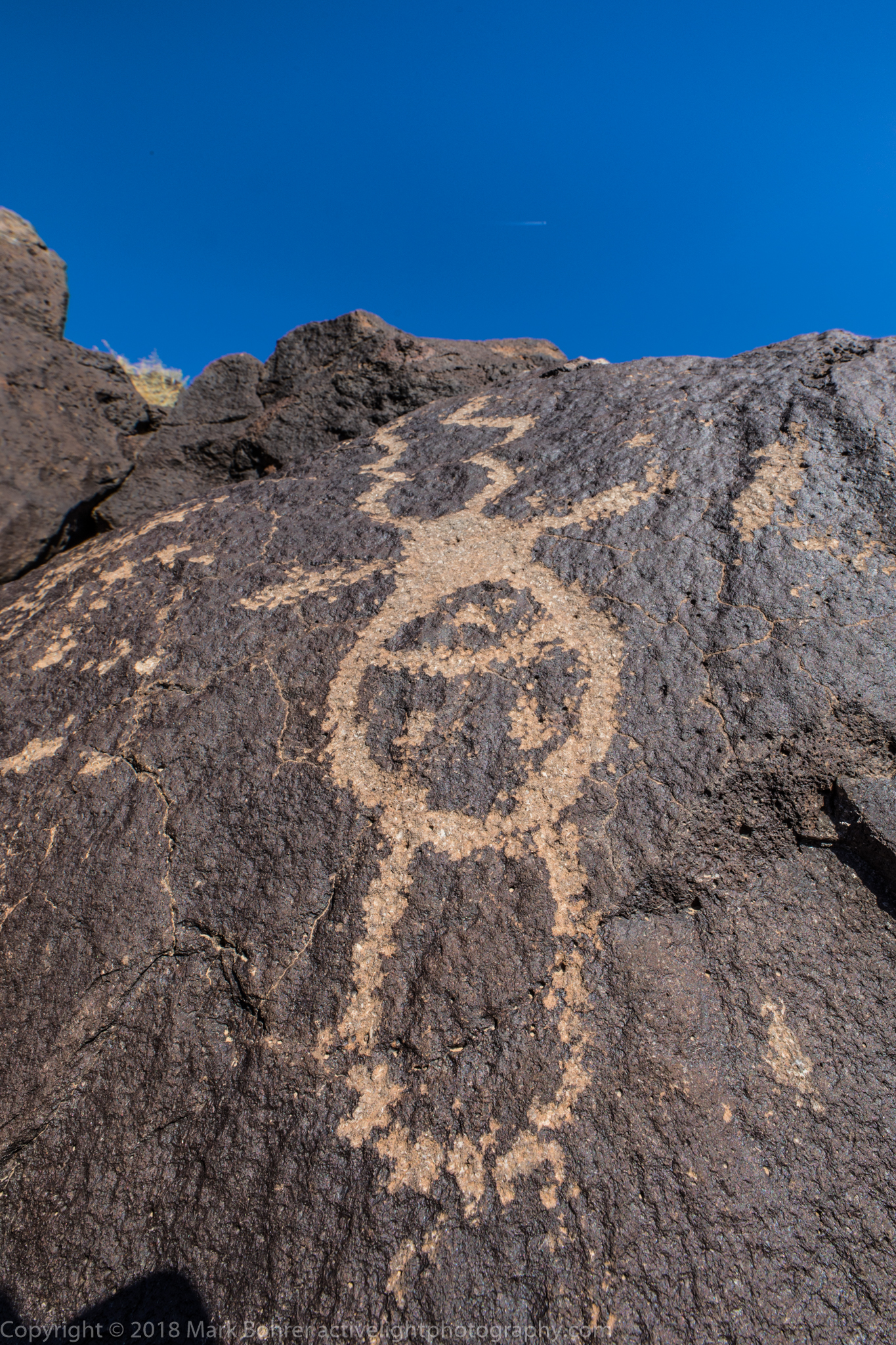 Falling from the sky – image of death Sigma 14mm f/1.8 DG HSM Art One of my early photo workshop students, Matt Schmader, was the superintendent of Albuquerque Open Space and an archaeologist by training. He gave insight into the possible meaning of one very different petroglyph, which shows a human figure upside down, appearing to fall from the sky. It seemed to him to be an image of death or human destruction. I’ve not seen anything else like it at Petroglyph National Monument, La Cieneguilla Petroglyph Site near Santa Fe, Chaco Canyon, or anywhere else in the Southwest. I photographed it close with the 14mm lens on the pocket tripod. 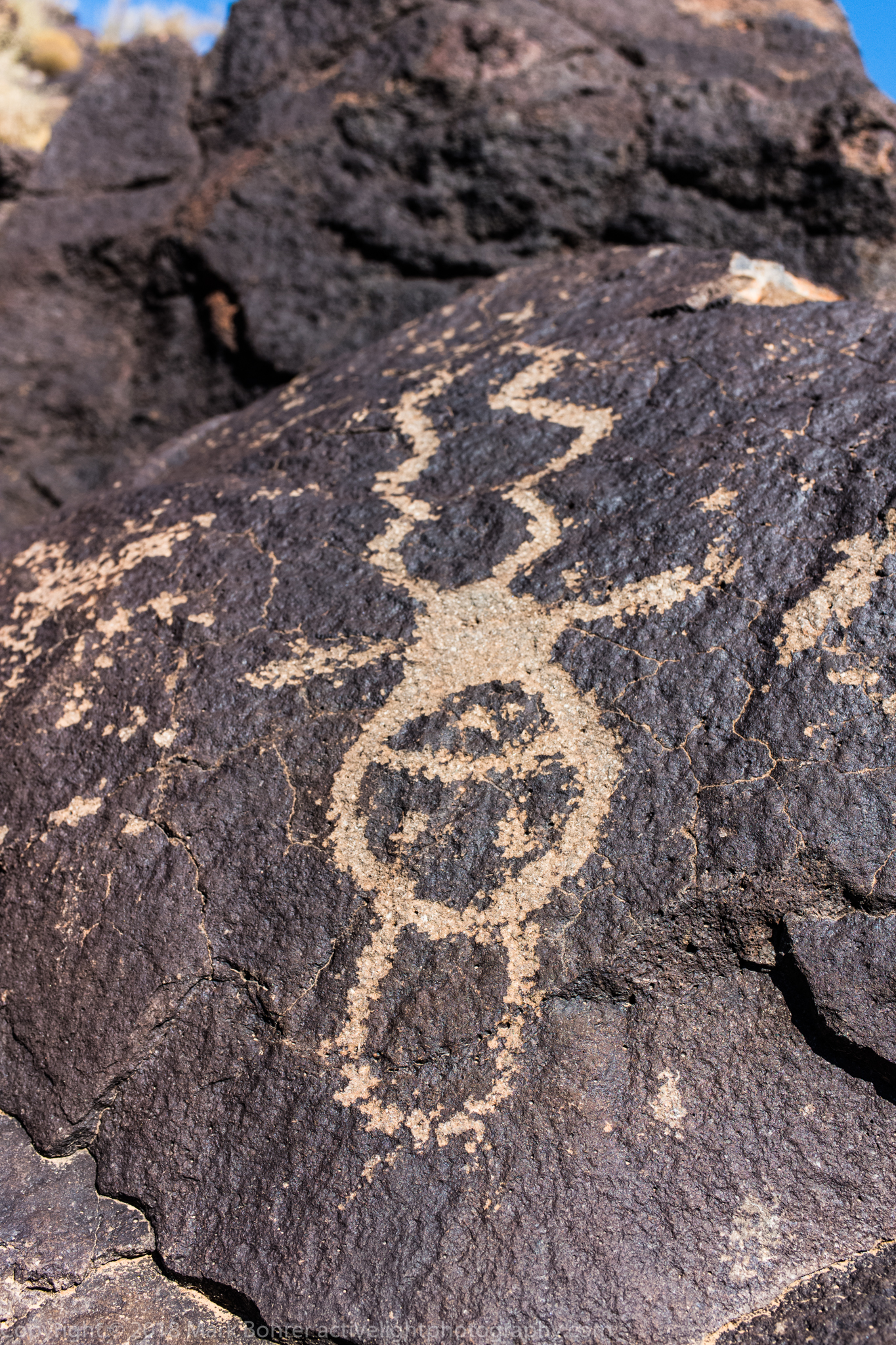 Falling from the sky – image of death Voigtlander 35mm f/1.2 Nokton Aspherical VM II Shoot The Options But I also decided to give myself choices, so I backed up slightly and put the Leica with 35mm on the pocket tripod, pointing the camera slightly down. Then I tweaked focus and aperture until I got the entire figure sharp, but blurred the background. The slivers of blue sky and blurred sand add more depth. 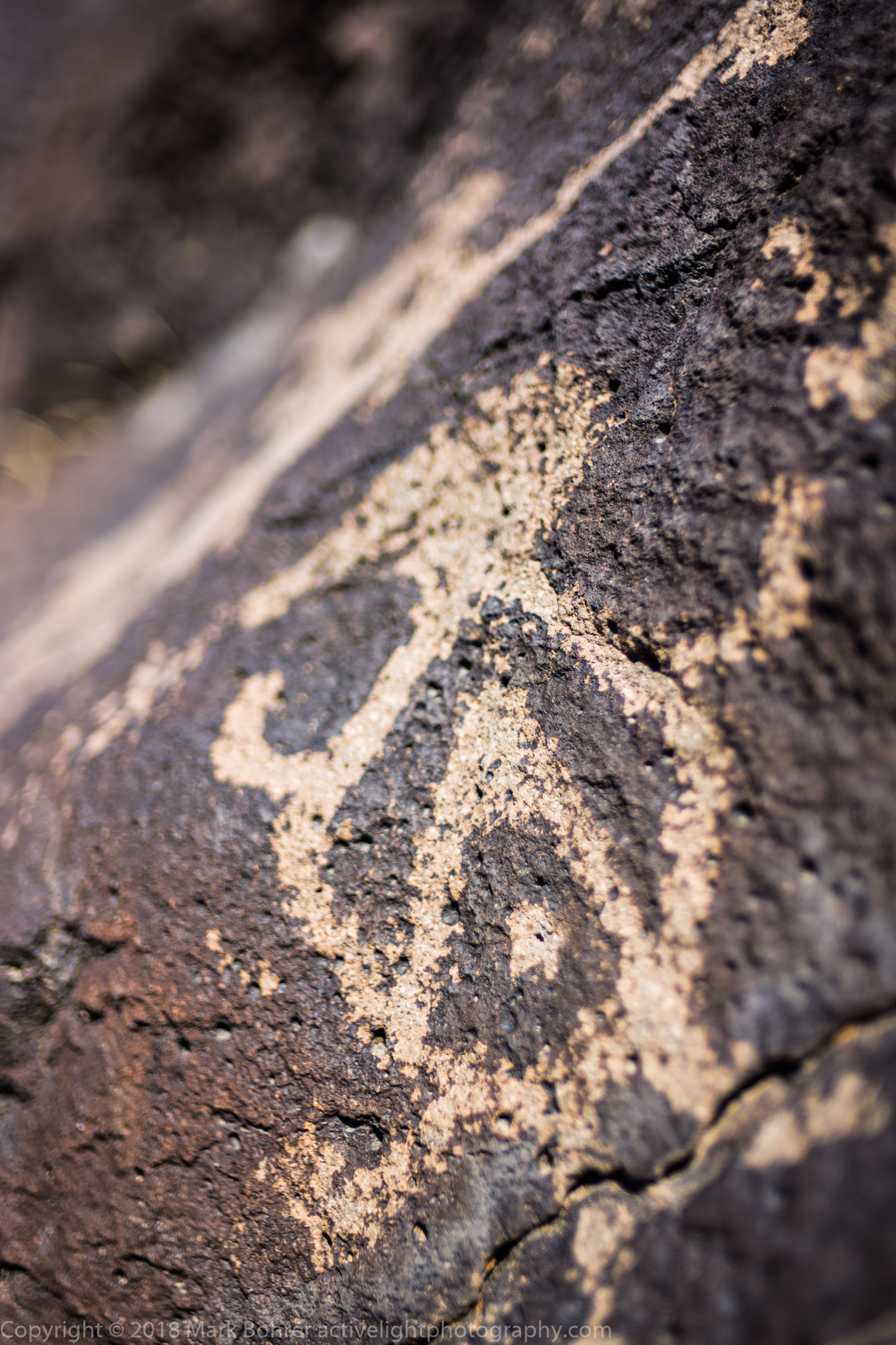 Turtle clan totem 35mm f/1.2 Nokton Aspherical VM II I wanted to try one shot at the tightest possible depth of field, so I set up the (probable) turtle clan totem shot with the 35mm Nokton at f/1.2. This was another one done with live view to check focus and precise composition. 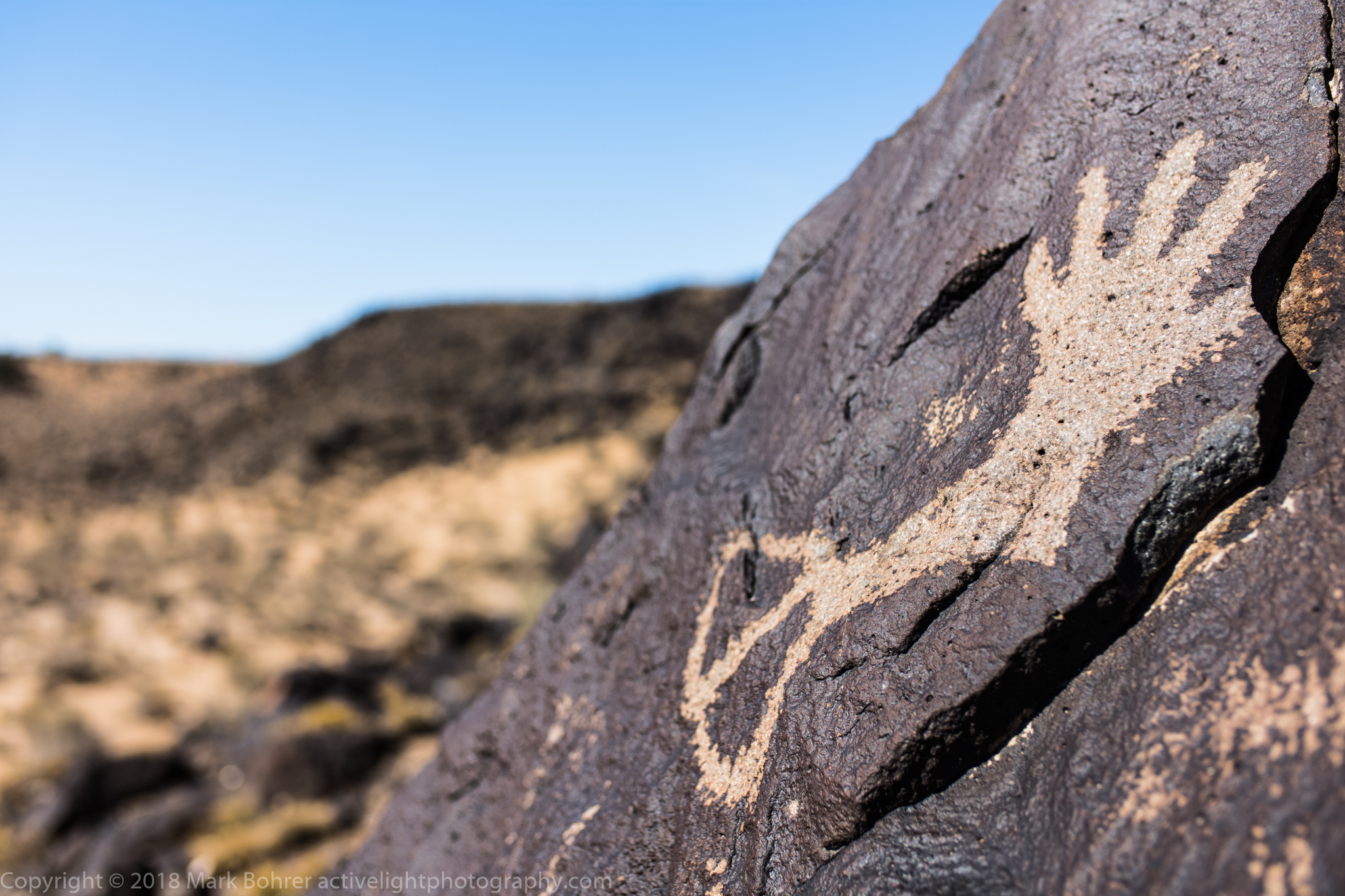 Triangle-base hand 35mm f/1.2 Nokton Aspherical VM II I wanted to do some more traditional compositions too. I’d shot the triangle-base hand ‘glyph before, but this time went as close as I could with the 35mm Nokton. I again adjusted focus and aperture for hand sharpness, and ended up with enough background detail for a good sense of place. Half the shot is that out-of-focus background.  Kachina and jumper 35mm f/1.2 Nokton Aspherical VM II Finally, the kachina and jumper are two of my favorite ‘glyphs. With almost direct sunlight, I went close to the Kachina, but used enough depth of field for the jumper to be sharp. Some cloud textures would have made the sky more interesting, but the clouds had by now gone away. The hard late-morning light meant it was time to go. I knew I had some good pictures on the memory cards, and looked forward to tweaking them on the big monitor at home. Shot Notes I knew I’d have to lift some contrast off reflective rock, shooting even roughly in the sun’s direction. This can be done selectively with Lightroom’s brush tool (press K on the keyboard). I used clarity and contrast adjustments together with highlight exposure reduction to get rid of some of the hazy shine in the shot of clan totems pointing at a visitor. The sun’s angle caused the hazy reflections on much of the rock’s surface, like an angled pool shot. Giving yourself an assignment different from the way you’ve shot before will unlock your creativity. I’ve photographed Petroglyph National Monument in every season and at most of the popular sites. Doing it closeup made me choose different perspectives and gave me stronger pictures. The ‘glyphs themselves are the enigmatic story, one of robust survival for a culture in a very harsh land. Want to shoot your own story? I offer guided photo tours to hidden Mesa Prieta inside Petroglyph National Monument, and other unknown areas in New Mexico. Discover these gorgeous and seldom-visited gems with me on your next vacation, and shoot your own story. Find out more here. More Information BBC Culture. (22 October 2013) Robert Capa at 100: The war photographer’s legacy. Retrieved from www.bbc.com/culture/story/20131022-robert-capa-photo-warrior B & H Photo Video. (n.d.) Really Right Stuff TFA-01 Ultra Pocket Pod and BH-25 LR Ball Head Package. Retrieved from www.bhphotovideo.com/c/product/1317756-REG/really_right_stuff_13720_tfa_01_ultra_pocket_pod.html. These pocket tripod packages cost a bit, but they provide a smooth-adjusting ballhead on three legs in a very small package. Small size makes it more likely I’ll have it with me. B & H Photo Video. (n.d.) Voigtlander Nokton 35mm f/1.2 Aspherical II Lens. Retrieved from https://www.bhphotovideo.com/c/product/827619-REG/Voigtlander_BA237B_Nokton_Aspherical_35mm_f_1_2.html. Here’s a source for this close-focusing and very fast 35mm f/1.2 lens, plus some specs and a description. B & H Photo Video. (n.d.) Sigma 14mm f/1.8 DG HSM Art Lens for Canon EF. Retrieved from https://www.bhphotovideo.com/c/product/1321306-REG/sigma_14mm_f_1_8_dg_hsm.html. Here’s where I bought this wide-aperture, close-focusing 14mm lens, plus some specs and a description. There’s a version for Nikon too. Cassario, J. (March 6, 2016) Battle of the 35’s – Nokton vs. Summilux. Retrieved from www.jaycassario.com/blog/2016/3/5/battle-of-the-35s-nokton-vs-summilux. A shootout between these two fast lenses, with a surprising conclusion. If you’re on the fence between Leica’s 35mm Summilux and the Voigtlander 35mm Nokton, the comparison shots will help you decide. City of Albuquerque Open Space Newsletter. (January-March 2017) Superintendent Dr. Matthew Schmader Retires! Retrieved from www.cabq.gov/parksandrecreation/documents/osd-newsletter-jan-mar-2017.pdf O’Hagan, S. (12 May 2012) The Guardian, Robert Capa and Gerda Taro: love in a time of war. Retreived from www.theguardian.com/artanddesign/2012/may/13/robert-capa-gerda-taro-relationship Reid, S. (April 20, 2015) CV 35/1.2 Nokton II. Retrieved from www.reidreviews.com. This site is available only with a $35 annual subscription, but if you use Leica M- or T/L-mount, Fuji X-mount, or Sony A-series cameras, it may be worth it. Yilmaz, O. (June 3, 2017) Voigtlander Nokton Aspherical 35mm f/1.2 Lens II Review. Retrieved from http://leica-review.com/voigtlander-nokton-aspherical-35mm-f-1-2-lens-ii-review/. Some nice interior and street shots with the Voigtlander 35mm Nokton. |
(408) 483-3782
Curious about how to shoot ruins?(408) 483-3782
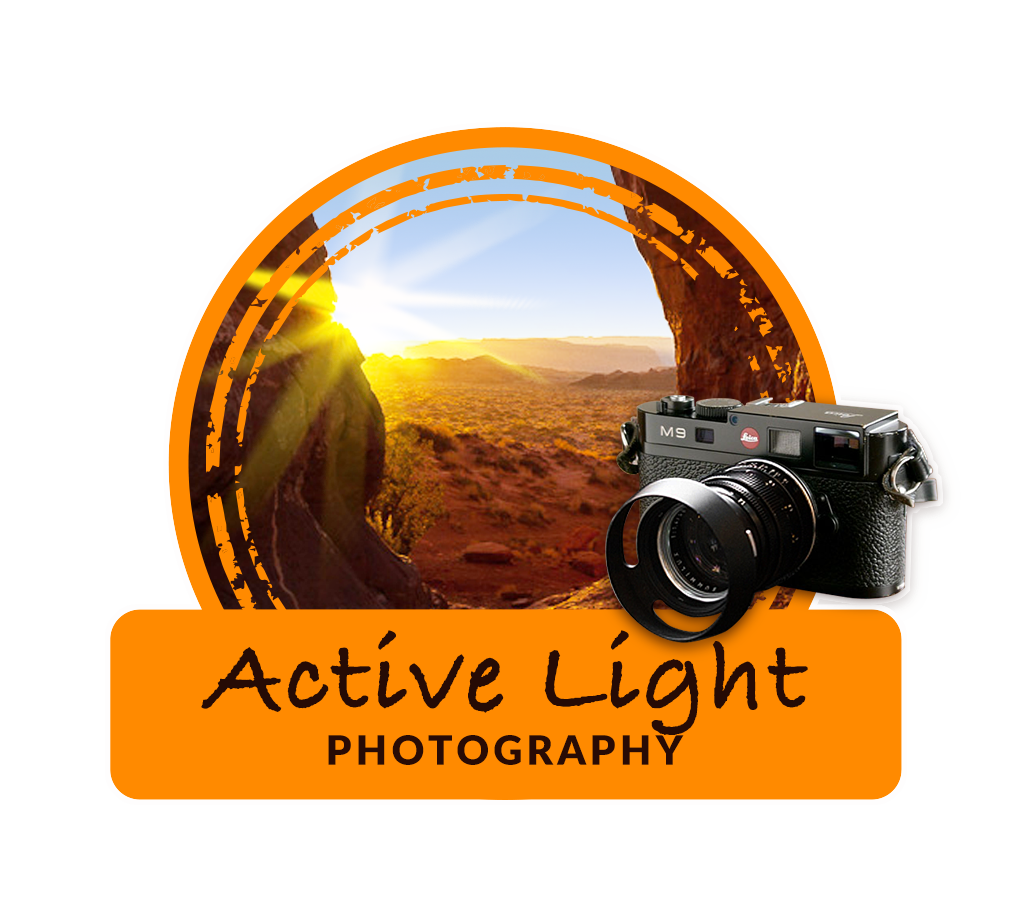
Recent Comments